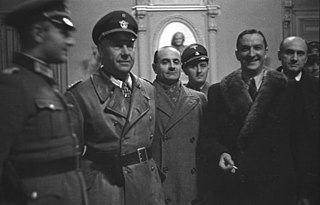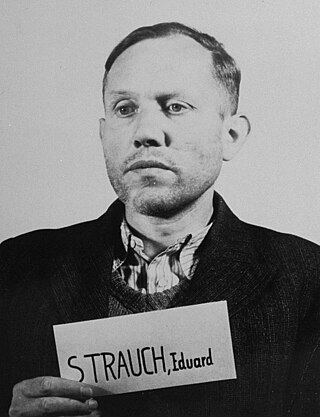
The Geheime Staatspolizei, abbreviated Gestapo, was the official secret police of Nazi Germany and in German-occupied Europe.
Sicherheitsdienst, full title Sicherheitsdienst des Reichsführers-SS, or SD, was the intelligence agency of the SS and the Nazi Party in Nazi Germany. Established in 1931, the SD was the first Nazi intelligence organization and the Gestapo was considered its sister organization through the integration of SS members and operational procedures. The SD was administered as an independent SS office between 1933 and 1939. That year, the SD was transferred over to the Reich Security Main Office, as one of its seven departments. Its first director, Reinhard Heydrich, intended for the SD to bring every single individual within the Third Reich's reach under "continuous supervision".

The Reich Security Main Office was an organization under Heinrich Himmler in his dual capacity as Chef der Deutschen Polizei and Reichsführer-SS, the head of the Nazi Party's Schutzstaffel (SS). The organization's stated duty was to fight all "enemies of the Reich" inside and outside the borders of Nazi Germany.

Gerhard Friedrich Ernst Flesch was a German SS functionary during the Nazi era. After World War II, he was tried, found guilty and executed for his crimes, specifically the torture and murder of members of the Norwegian resistance movement.

The Sicherheitspolizei, often abbreviated as SiPo, was a term used in Germany for security police. In the Nazi era, it referred to the state political and criminal investigation security agencies. It was made up by the combined forces of the Gestapo and the Kriminalpolizei between 1936 and 1939. As a formal agency, the SiPo was incorporated into the Reich Security Main Office (RSHA) in 1939, but the term continued to be used informally until the end of World War II in Europe.
SIPO or Sipo can refer to:

Franz Walter Stahlecker was commander of the SS security forces (Sicherheitspolizei and the Sicherheitsdienst for the Reichskommissariat Ostland in 1941–42. Stahlecker commanded Einsatzgruppe A, the most murderous of the four Einsatzgruppen active in German-occupied Eastern Europe. He was fatally wounded in action by Soviet partisans and was replaced by Heinz Jost.
There were two main Police forces of Nazi Germany under the Reichsführer-SS, Heinrich Himmler from 1936:
The Lithuanian Security Police (LSP), also known as Saugumas, was a local police force that operated in German-occupied Lithuania from 1941 to 1944, in collaboration with the occupational authorities. Collaborating with the Nazi Sipo and SD, the unit was directly subordinate to the German Kripo. The LSP took part in perpetrating the Holocaust in Lithuania, persecuting the Polish resistance and communist underground.
Ain Mere was an Estonian military officer in World War II. During the German occupation of Estonia, he served in the German-controlled Estonian Security Police and SD.
A number of war crimes trials were held during the Soviet occupation of Estonia (1944–1991). The best-known trial was brought in 1961, by the Soviet authorities against local collaborators who had participated in the Holocaust during the German occupation (1941–1944). The accused were charged with murdering up to 5,000 German and Czechoslovakian Jews and Romani people near the Jägala concentration camp in 1942–1943. The public trial by the Supreme Court of the Estonian SSR was held in the auditorium of the Navy Officers Club in Tallinn and attended by a mass audience. All three defendants were convicted and sentenced to death, one in absentia. The two defendants present for the trial were executed shortly after. The third defendant, Ain-Ervin Mere, was not available for execution.

The Holocaust in Estonia refers to Nazi crimes during the occupation of Estonia by Nazi Germany.

Martin Sandberger was a German SS functionary during the Nazi era and a convicted Holocaust perpetrator. He commanded Sonderkommando 1a of Einsatzgruppe A, as well as the Sicherheitspolizei and SD at the time of Nazi German occupation of Estonia during World War II. Sandberger perpetrated mass murder of the Jews in German-occupied Latvia and Estonia. He was also responsible for the arrest of Jews in Italy, and their deportation to Auschwitz concentration camp. Sandberger was the second-highest official of the Einsatzgruppe A to be tried and convicted. He was also the last-surviving defendant from the Nuremberg Military Tribunals.

The Reichskommissariat Niederlande was the civilian occupation regime set up by Germany in the German-occupied Netherlands during World War II. Its full title was the Reich Commissariat for the Occupied Dutch Territories. The administration was headed by Arthur Seyss-Inquart, formerly the last chancellor of Austria before initiating its annexation by Germany.
A field force in British, Indian Army and Tanzanian military parlance is a combined arms land force operating under actual or assumed combat circumstances, usually for the length of a specific military campaign. It is used by other nations, but can have a different meaning.

Eduard Strauch was a German Nazi SS functionary, commander of Einsatzkommando 2, commander of two Nazi organizations, the Security Police, or Sipo, and the Security Service, first in Belarus – then called White Russia or White Ruthenia – and later in Belgium. In October 1944, he was transferred to the militarised branch of the SS, the Waffen-SS.
Ukrainian People's Militsiya or the Ukrainian National Militsiya, was a paramilitary formation created by the Organization of Ukrainian Nationalists (OUN) in the General Government territory of occupied Poland and later in the Reichskommissariat Ukraine during World War II. It was set up in the course of Operation Barbarossa, the 1941 invasion of the Soviet Union.
Kriminalpolizei, often abbreviated as Kripo, is the German name for a criminal investigation department. This article deals with the agency during the Nazi era.

The Sicherheitspolizei, or security police, was a militarized German police group set up in most states of the Weimar Republic at the end of 1919 and largely financed by the central government. In its anti-riot role it can be seen as roughly analogous to the Bereitschaftspolizei in today's Federal Republic.

The Polish Criminal Police was a non-uniformed, armed and secret formation of auxiliary police, colloquially called “Polish Kripo”, active in the years 1940-1945 in the General Government during the German occupation of Poland.










